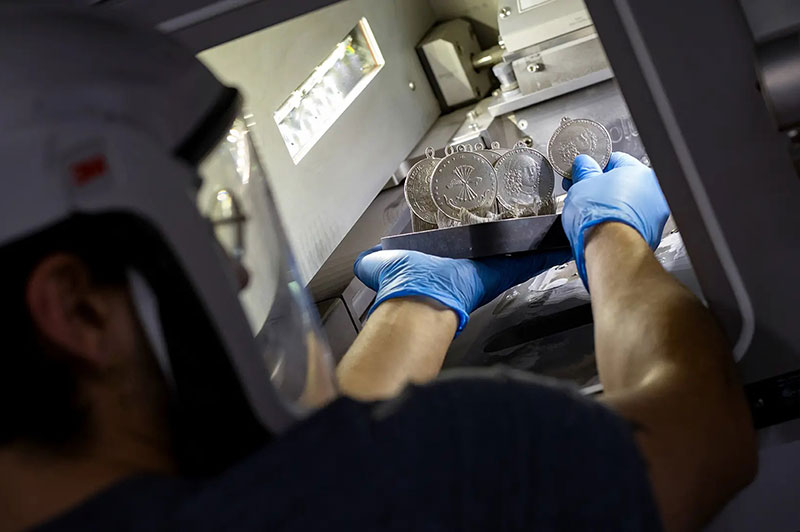Project Embraces Tribal History With Modern Technology
Written by Annie Krakower for Maryland Today Motors whirred and lasers sparked in the Chemical and Nuclear Engineering Building this week, and the safety glass on an advanced 3D metal printer was at once a window into the future of manufacturing and a centuries-old Indigenous past. The Piscataway Tribe, on whose ancestral lands the University of Maryland sits, is collaborating with the A. James Clark School of Engineering’s Terrapin Works makerspace to create replicas of three peace medals, 2-inch silver tokens of goodwill that colonists presented to Native leaders in the 1600s and 1700s. The 3D-printed artifacts, made from the nickel-chromium-based superalloy Inconel on industrial-grade printers around campus, will serve as accessible educational tools for Piscataway youth, UMD students and others around the DMV. “We want to be able to tell the full and complete story,” said Piscataway tribal member and historian Mario Harley. “(The replicas) become a physical reminder that people can come see and touch to be able to understand this aspect of not only colonial Maryland history or colonial Pennsylvania history, but also early American history.” When conducting tribal research and digging through Maryland’s state archives, he discovered that the three original medals were stowed away at the Maryland Center for History and Culture in Baltimore. One, called the Calvert Peace Medal, pictures Cecil Calvert, the second Lord Baltimore, on the front, and his wife (and county namesake) Anne Arundell, on the back; colonists presented it to the Susquehannock, who had been pushed into Piscataway lands, as part of the Treaty of 1652. The second, called the Calvert Maryland Map Medal, was given to Piscataway leaders in 1676; it features Calvert on the front and a map of Maryland on the back. Fewer details are known about the third, but its design showing six arrows hints it could have been created around the time of the Treaty of Lancaster in 1744, Harley said, symbolizing the Haudenosaunee, or Iroquois Confederacy of Six Nations. No living member of his tribe had ever seen these artifacts, and Harley hoped to make them more broadly available to the public to help “validate our oral histories,” he said. After previously working with UMD to create 3D scans of a stone ax head and gorget (a Native American pendant), he reached back out to see if they could replicate the medals. Due to the medals’ intricate details, Rick Blanton, the Clark School’s director of technical operations who oversees Terrapin Works, recommended first creating a 3D scan at Direct Dimensions, an Owings Mills, Md., facility whose high-tech work has included sets, props and costumes in the Marvel Cinematic Universe. The laser scans, completed there last week, generated a “point cloud” of each medal’s surface, with software stitching the points together into digital 3D models. Terrapin Works, which has 3D-printed objects ranging from mini-Testudo statues to busts of Maryland legislators, received those models Monday and soon began the printing process. The first batch of nine medals—three of each—took around 10 hours to complete on an SLM 125 metal printer, including adding a necklace loop to one of the medals and increasing the diameter of the smaller Calvert Maryland Map Medal to match the others. “When you’re working with details that are that precise—less than half a millimeter—you can really capture exactly what you’re trying to recreate, which for this purpose is amazing,” said Bobby Alban ’25, an aerospace engineering major and technical coordinator who helps run Terrapin Works’ metal printers. After carefully cleaning the metal powder off the copies with a vacuum, the Terrapin Works team will perform a thorough post-processing of the medals to ensure they look as good as possible. They’ll also try different metal mixtures on other printers on campus to create around a dozen copies for UMD, Direct Dimensions and the Piscataway, who will be presented with the medals prior to Thanksgiving to celebrate Native and Indigenous Heritage Month. “There’s a benefit to being able to see that convergence of historical artifacts and the latest technologies, and blending those together,” Blanton said. Harley sees potential to similarly replicate other rare tribal items, like a pipe made of the stone catlinite that was found near the Anacostia River and a food storage pot found near Pope’s Creek, a Potomac River tributary. He hopes such artifacts can enhance teaching at UMD—such as in the University Honors course “Contemporary Indigenous Perspectives on History, Traditions and Modern Issues” that he and the Piscataway helped develop—and beyond. “Our interaction with the University of Maryland has been steadily expanding,” Harley said. “We’re very proud that the leadership has been very supportive in working with us.” In the News"Centuries later, U.Md. recreating peace coins for state’s tribal descendants," WTOP, November 22, 2024
Related Articles: November 21, 2024 Prev Next |


